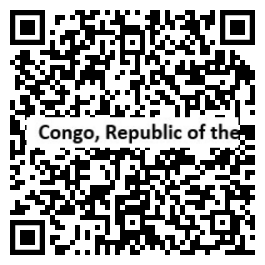Introduction
Background
Upon independence in 1960, the former French region of Middle Congo became the Republic of the Congo. A quarter century of experimentation with Marxism was abandoned in 1990 and a democratically elected government took office in 1992. The Republic of Congo is one of Africa's largest petroleum producers.
Geography
Area
total: 342,000 sq km
land: 341,500 sq km
water: 500 sq km
Climate
tropical; rainy season (March to June); dry season (June to October); persistent high temperatures and humidity; particularly enervating climate astride the Equator
Natural resources
petroleum, timber, potash, lead, zinc, uranium, copper, phosphates, gold, magnesium, natural gas, hydropower
People and Society
Population
5,677,493 (2023 est.)
Ethnic groups
Kongo (Bakongo) 40.5%, Teke 16.9%, Mbochi 13.1%, foreigner 8.2%, Sangha 5.6%, Mbere/Mbeti/Kele 4.4%, Punu 4.3%, Pygmy 1.6%, Oubanguiens 1.6%, Duma 1.5%, Makaa 1.3%, other and unspecified 1% (2014-15 est.)
Languages
French (official), French Lingala and Monokutuba (lingua franca trade languages), many local languages and dialects (of which Kikongo is the most widespread)
Religions
Roman Catholic 33.1%, Awakening Churches/Christian Revival 22.3%, Protestant 19.9%, Salutiste 2.2%, Muslim 1.6%, Kimbanguiste 1.5%, other 8.1%, none 11.3% (2007 est.)
Population growth rate
2.4% (2023 est.)
Government
Government type
presidential republic
Capital
name: Brazzaville
Executive branch
chief of state: President Denis SASSOU-Nguesso (since 1997)
head of government: Prime Anatole Collinet MAKOSSO (since 12 May 2021)
Legislative branch
description: bicameral Parliament or Parliament consists of:
Senate (72 seats; members indirectly elected by local, district, and regional councils by simple majority vote to serve 6-year terms) note- the Senate is renewed in its entirety following a constitutional reform implemented in 2015 ending the renewal by half
National Assembly (151 seats; members directly elected in single-seat constituencies by absolute majority popular vote in 2 rounds if needed; members serve 5-year terms)
Economy
Economic overview
primarily an oil- and natural resources-based economy; recovery from mid-2010s oil devaluation has been slow and curtailed by COVID-19; extreme poverty increasing, particularly in southern rural regions; attempting to implement recommended CEMAC reforms; increasing likelihood of debt default
Real GDP (purchasing power parity)
$18.875 billion (2021 est.)
$19.3 billion (2020 est.)
$20.584 billion (2019 est.)
Real GDP per capita
$3,200 (2021 est.)
$3,400 (2020 est.)
$3,700 (2019 est.)
Agricultural products
cassava, sugar cane, oil palm fruit, cassava leaves, bananas, plantains, roots/tubers, game meat, vegetables, mangoes/guavas
Industries
petroleum extraction, cement, lumber, brewing, sugar, palm oil, soap, flour, cigarettes
Remittances
0.12% of GDP (2020 est.)
0.21% of GDP (2019 est.)
0.08% of GDP (2016 est.)
Exports
$4.67 billion (2020 est.)
$7.855 billion (2019 est.)
Exports - partners
China 49%, United Arab Emirates 15%, India 6%, Italy 5% (2019)
Exports - commodities
copper, crude petroleum, refined petroleum, lumber, tin (2021)
Imports
$3.279 billion (2020 est.)
$4.945 billion (2019 est.)
Imports - partners
China 15%, France 12%, Belgium 6%, Angola 5% (2019)
Imports - commodities
ships, chicken products, refined petroleum, processed fish, packaged medicines (2019)
Exchange rates
Cooperation Financiere en Afrique Centrale francs (XAF) per US dollar -
Exchange rates:
554.531 (2021 est.)
575.586 (2020 est.)
585.911 (2019 est.)
555.446 (2018 est.)
580.657 (2017 est.)
Page last updated: Wednesday, December 06, 2023
